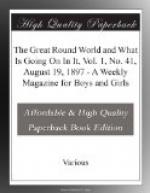The stories of these enormous fortunes have set the Californian and Northwestern towns in a fever of excitement. A tremendous rush is being made for the Klondike. Men are leaving good employment and hurrying off to the gold-fields. Professional men (lawyers and doctors), business men, merchants, clerks, and laborers are all joining in the mad rush for the land of gold.
The excitement is as great as it was in ’49, but the terrible experiences of that year have now become ancient history, and the gold-seekers have to learn the sad lesson anew. It looks as if this land of gold would, like California in ’49, become a land of death.
When the gold fever reached the Eastern States in the spring of ’49, there was just the same mad rush for California that is now being made for the Klondike.
The emigrants had in those days to cross the prairies in wagons. None of them understood the rigors of the journey they had to undertake, and many fell by the wayside and died before the promised land was reached. After a while the track across this great American desert was marked by the skeletons of oxen and horses, and boxes and barrels which people had thrown out of their wagons to lighten the load of their poor weary beasts, to enable them to reach water and shade. Here and there a rough mound would mark where some poor soul had been unable to bear the sufferings and had given up his life.
Thousands died in the awful trip across the continent, and thousands more, who thought to make an easier journey by sea, died of fevers contracted in crossing the unhealthy Isthmus of Panama, the strip of land that divides North and South America, separating the Atlantic from the Pacific Ocean.
The historian Bancroft says that while between four and five hundred millions of gold were obtained in the seven years following the find in ’49, the gold cost, in human life and labor, three times what it was actually worth.
A few of the Forty-niners gained the riches they sought, but the greater part of the gold-seekers barely made a living by the most exhausting toil.
[Illustration: Forty-niners crossing the Plains.]
As regards the Klondike, all the miners who have returned declare that the life is so hard that only the very healthy can stand it. In spite of this warning, weak and delicate men, and men who have lived in luxury all their lives, are setting their faces toward the north, to undertake a life of untiring labor and privation, in the intense cold of an Arctic region in winter, and the most extreme heat in the three short months of summer.
During this latter season the sun does not set till 10.30, and rises again at 3 A.M. There is no darkness, midnight being almost as light as midday. During the hot months all kinds of insects pester the inhabitants. The horseflies and mosquitoes swarm in such numbers that the rigors of winter are considered preferable to the warmth of summer.




